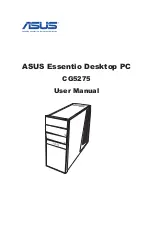
Chapter 2
2-16
The mainboard provides a DVI (Digital Visual Interface) connector
which allows you to connect an LCD monitor. The DVI connector provides a
high-speed digital interconnection between the computer and its display device.
P i n
1
2
3
4
5
6
7
8
9
1 0
1 1
1 2
DVI-I Connector
Signal Assignment
T.M.D.S.* Data2-
T.M.D.S. Data2+
T.M.D.S. Data2/4 Shield
T.M.D.S. Data4-
T.M.D.S. Data4+
DDC Clock
DDC Data
N/C
T.M.D.S. Data1-
T.M.D.S. Data1+
T.M.D.S. Data1/3 Shield
T.M.D.S. Data3-
P i n
1 3
1 4
1 5
1 6
1 7
1 8
1 9
2 0
2 1
2 2
2 3
2 4
Signal Assignment
T.M.D.S. Data3+
+5V
GND (for +5V)
Hot Plug Detect
T.M.D.S. Data0-
T.M.D.S. Data0+
T.M.D.S. Data0/5 Shield
T.M.D.S. Data5-
T.M.D.S. Data5+
T.M.D.S. Clock Shield
T.M.D.S. Clock+
T.M.D.S. Clock-
C 1 Analog Red
C 2 Analog Green
C 3 Analog Blue
*T.M.D.S. Technology
The graphics data sent to the digital monitor use Transition Minimized
Differential Signalling (T.M.D.S.) technology. TMDS uses an encoding
algorithm to 8-bit of data into a 10-bit transition minimized, DC balanced
character, which are transition-minimized to reduce EMI with copper
cables and DC-balanced for transmission over fiber optic cables. The
TMDS algorithm also provides robust clock recovery for greater skew
tolerance with longer cables or low cost short cables.
- No analog output in this model.
1
24
17
8
C1 C2
C3
DVI Connector: DVI1 (Digital Output Only)















































